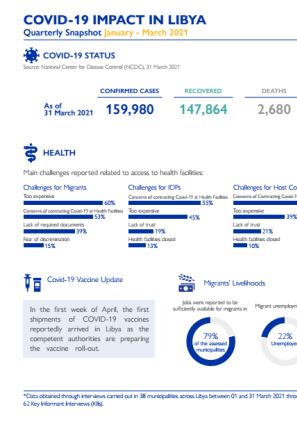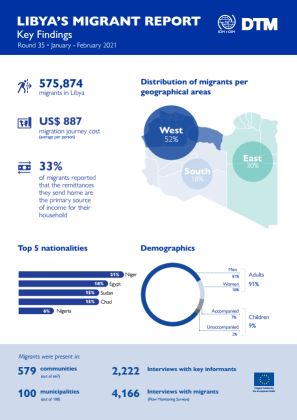-
Countries
-
Data and Analysis
-
Special Focus
-
Crisis Responses
Libya
About Libya
Libya is a geographically vast country with several regions that are difficult to access. In order to understand the full scope of humanitarian assistance that is needed throughout the country, IOM established the Displacement Tracking Matrix (DTM) programme in 2016 in order to provide a common operating picture concerning the movement of populations in Libya, allowing humanitarian actors to provide timely assistance to those in need. Following the escalation of conflict and insecurity in 2014, the security situation has remained volatile since with fluctuations in the intensity of localized clashes. Congruently, conflict has caused new displacements, often in areas ill-equipped to accommodate large population movements while also negatively impacting the large migrant population residing and transiting through Libya. More recently, the capital Tripoli was heavily affected by displacement waves in September 2018 and April 2019.
DTM’s mobility tracking and flow monitoring activities identified many migrants in-country to be in need of various forms of assistance. Libya’s geographic location, resources and work opportunities has made it both a country of destination and transit for migrants for many years. Despite the deterioration of the security situation since 2011 migrants continue coming to and transiting through Libya, the majority from Sub-Saharan and North African countries.
In this complex operating environment, DTM Libya has been providing a common operating picture concerning the movement of populations in Libya since 2016, allowing humanitarian actors to provide timely assistance to those in need. Through its mobility tracking, flow monitoring and needs assessment activities, DTM Libya has established itself as data hub for quantitative data on migratory flows to and within Libya, migrant presence in Libya disaggregated by nationality and area, as well as humanitarian needs of migrants, internally displaced population and returnees. All activities are implemented through periodical bi-monthly data collection cycles, allowing trend analysis over time to provide evidence-base for both policy-level discussions and to guide humanitarian action.
In order to facilitate humanitarian interventions, DTM works closely with IOM’s other programmes through referring identified populations in need of assistance at flow monitoring points to IOM’s Direct Assistance, Health, Voluntary Humanitarian Return (VHR), Protection and Migrant Rapid Response Mechanism (MRRM) programmes. Furthermore, DTM Libya supports other humanitarian partners through providing emergency tracking updates in case of sudden population movements as well as facilitating humanitarian assessments for the Rapid Response Mechanism (RRM) jointly implemented by IOM, UNICEF, WFP and UNFPA.
For more information on IOM's activities in Libya, please visit the IOM Libya country office website.
Contact
DTM Libya
DTMLibya@iom.int
Current Donors
- EUTF
COVID-19 Impact In Libya Dashboard (April - May 2021)
The dashboard presents snapshot of COVID-19's impact in Libya during April - May 2021.
Libya — Detention Centre Profile Generator (May 2021)
Detention Centre Profiling is a component of IOM Libya’s Displacement Matrix programme.
Libya — Mobility in The Chad-Libya-Niger Triangle (August 2019 - September 2020)
This joint study from IOM Chad, IOM Niger and IOM Libya explores the context, scale and nature of migration dynamics among these countries.
Libya — Circular Migration to Libya (2020)
The study shows that circular migration to Libya represents a significant share of the overall migration influx to Libya, with estimates indicating that up to 13% of the migrant population in Libya could be identified as migrant workers employed on a seasonal basis and returning to their countrie
May 25 2021
Libya — Circular Migration to Libya (2020)
IOM Libya and Georgetown University: Mapping Labour Skills of Migrants in Misrata
To learn more about the lives of migrants in Misrata, IOM Libya partnered with Georgetown University’s Center for Contemporary Arab Studies (CCAS) to conduct a mixed-method study consisting of literature review, qualitative interviews and a quantitative survey administered to nearly 1,000 migrant
Libya — Intention Survey Of Tawergha IDPs (May 2021)
In 2011 around 40,000 people from Tawergha were forcibly displaced due to armed conflict and hostilities. The damage to public and private infrastructure has left the town unhabitable, and so far, only around 6,900 individuals have returned as of May 2021.
Libya — Migrant Report 35 (January—February 2021) [Arabic]
خلال شهري يناير وفبراير من سنة 2021 تم إحصاء 575.874 مهاجرا ينحدر أصلهم من أكثر من 41 جنسية مختلفة في جميع بلديات ليبيا الـ100 وفي إطار الجولة 35 من تجميع مصفوفة تتبع النزوح للبيانات. وتماشيا مع آخر جولة لتجميع البيانات، ظلّ عدد المهاجرين المتواجدين في ليبيا مستقرّا إلى حدّ ما في م
Libya — Detention Centre Profile Generator (April 2021)
Detention Centre Profiling is a component of IOM Libya’s Displacement Matrix programme.
Libya — IDP and Returnee Report 37 (May - June 2021) [Arabic]
يستعرض هذا التقرير نتائج الجولة السابعة والثلاثين المستخلصة من عمل وحدة تتبّع التنقل الخاصّة بمصفوفة تتبع النزوح في ليبيا والتي تغطّي الفترة الممتدّة بين شهري مايو ويونيو من سنة 2021.
Libya — IDP and Returnee Report 35 (Jan - Feb 2021) [Arabic]
يستعرض هذا التقرير نتائج الجولة الخامسة والثلاثين المستخلصة من عمل وحدة تتبّع التنقل الخاصّة بمصفوفة تتبع النزوح في ليبيا والتي تشمل الفترة الممتدّة بين شهري يناير وفبراير من سنة 2021.
Libya — IDP and Returnee Report 35 (January - February 2021)
This report presents the findings of round 35 of the Mobility Tracking component of IOM Libya’s Displacement Tracking Matrix (DTM) programme, covering January – February 2021.
Libya — IDP And Returnee Key Findings Report 35 (January - February 2021)
This infographic presents the key findings of Round 35 of the mobility tracking component of the Displacement Tracking Matrix (DTM) programme in Libya.
COVID-19 Impact in Libya Dashboard (January - March 2021)
The dashboard presents snapshot of COVID-19's impact in Libya during January - March 2021.
Migrant Report Key Findings 35 (January — February 2021)
This infographic presents the key findings of Round 35 of the mobility tracking component of the Displacement Tracking Matrix (DTM) programme in Libya.
Libya — Migrant Report 35 (January—February 2021)
In January and February 2021, 575,874 migrants from over 41 nationalities were identified in all 100 Libyan municipalities during Round 35 of DTM data collection.
Libya — Detention Centre Profile Generator (March 2021)
Detention Centre Profiling is a component of IOM Libya’s Displacement Matrix programme.
Labour Migration to Libya - Remittances Amidst Conflict and Pandemic
This study presents key findings about remittances sent by migrants from Libya to their countries of origin, utilizing microdata collected from over 41,000 migrant interviews conducted in 2019-2020, including self-reported data on remittances disclosed by 13,738 migrants.
Libya — Detention Centre Profile Generator (February 2021)
Detention Centre Profiling is a component of IOM Libya’s Displacement Matrix programme.
Ministry of IDP Affairs & IOM: Internal Displacement in Libya (2019-2020) [Arabic]
This joint publication presents an overview of trends, movements, profiles and demographics of IDPs who were displaced in 2019-2020 based on information jointly analyzed by the Ministry of Displaced People’s Affairs and IOM Libya’s Displacement Tracking Matrix (DTM) programme.
Mar 04 2021
Ministry of IDP Affairs & IOM: Internal Displa…
Ministry of IDP Affairs & IOM: Internal Displacement in Libya (2019-2020)
This joint publication presents an overview of trends, movements, profiles and demographics of IDPs who were displaced in 2019-2020 based on information jointly analyzed by the Ministry of Displaced People’s Affairs and IOM Libya’s Displacement Tracking Matrix (DTM) programme.
Mar 04 2021
Ministry of IDP Affairs & IOM: Internal Displa…
Libya — IDP And Returnee Report 34 (November - December 2020) [Arabic]
This report presents the findings of round 34 of the Mobility Tracking component of IOM Libya’s Displacement Tracking Matrix (DTM) programme, covering November and December 2020.
Libya — IDP And Returnee Key Findings Report 34 (November - December 2020)
This infographic presents the key findings of Round 34 of the mobility tracking component of the Displacement Tracking Matrix (DTM) programme in Libya.
Libya — IDP And Returnee Report 34 (November - December 2020)
This report presents the findings of round 34 of the Mobility Tracking component of IOM Libya’s Displacement Tracking Matrix (DTM) programme, covering November and December 2020.
Libya — Migrant Report Key Findings Round 34 (November-December 2020)
This infographic presents the key findings of Round 34 of the mobility tracking component of the Displacement Tracking Matrix (DTM) programme in Libya.
Pagination
Pagination
- First page
- Previous page
- 1
- 2
- 3
- 4
- 5






















